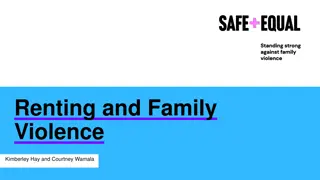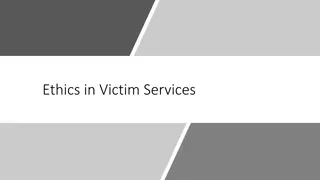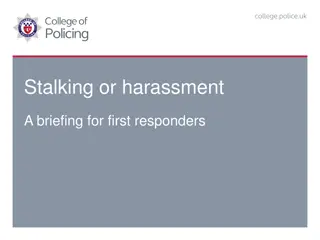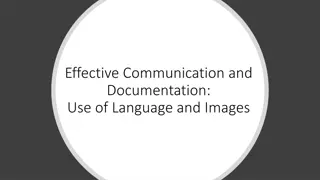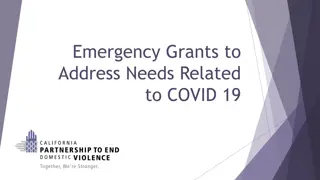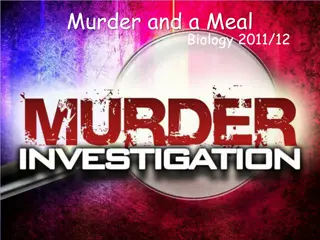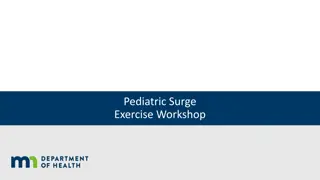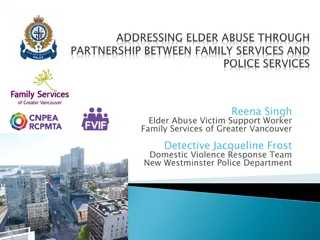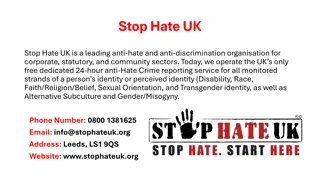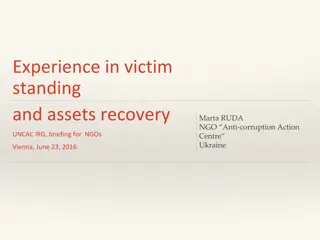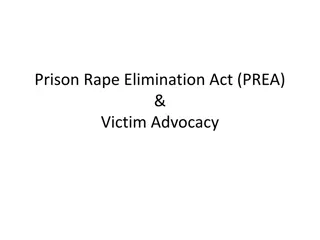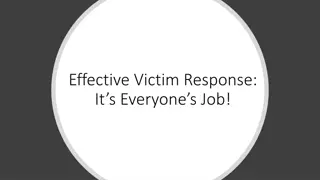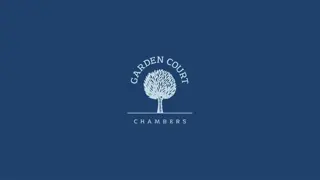Comprehensive Guide to Victim Services Documentation
Explore the importance of documenting law enforcement-based victim services, learning objectives, personnel responsibilities, service provision models, access to documentation, and the purpose of different documentation types in victim services. Understand how to record contact, document actions taken, and safeguard information effectively.
Download Presentation

Please find below an Image/Link to download the presentation.
The content on the website is provided AS IS for your information and personal use only. It may not be sold, licensed, or shared on other websites without obtaining consent from the author.If you encounter any issues during the download, it is possible that the publisher has removed the file from their server.
You are allowed to download the files provided on this website for personal or commercial use, subject to the condition that they are used lawfully. All files are the property of their respective owners.
The content on the website is provided AS IS for your information and personal use only. It may not be sold, licensed, or shared on other websites without obtaining consent from the author.
E N D
Presentation Transcript
Learning Objectives Identify the purpose of law enforcement-based victim services documentation. 1 2 Discuss common language pitfalls and how to avoid them in documentation. Review how to properly document law enforcement-based victim services actions. 3
First Responder Supervisor (Sworn) Investigator Personnel Responsibilities Victim Supervisor (Victim Services) Victim Services
Models of Service Provision Law Hybrid Community- Based Victim Services Community- Based Victim Services Enforcement- Based Victim Services
Documentation Purposes Record of Contact Guides Next Steps Useful Information Verification of Actions and Services CVC Subpoena Reference Information
Access to Law Enforcement-Based Victim Services Documentation Law Victims Suspects Prosecutors Enforcement Defense Attorneys Other Agencies Media Public
[Agency] Victim Services Documentation
Documentation Basic Information Response Information Enter date and describe type of response and contact (in-person, virtually, by phone) Identify individuals you had contact with (e.g., victims, agency personnel) Identify People Victim Information Document relevant information provided by victim
Documentation Actions Taken Describe actions taken by YOU Do not restate actions taken by others. This may lead to discrepancies and confusion. Actions Mandated Reporting Describe information leading to referral Include reference number and caller ID number Document all services provided crisis intervention, safety planning, criminal justice support, accompaniment, and transportation Services
Documentation Action Taken Housing, trauma support, CVC, medical needs, funeral homes, crime-scene clean up, protection orders, community agencies Supportive handoffs whenever possible Referrals Unanswered victim questions Spontaneous disclosures Unmet Needs
Documentation Reminders Minors and Older/Vulnerable Adults Connectivity to Systems Agency Systems Recognize Personal Preconceptions Consider Context Language and Cultural Needs Prosecution and Subpoenas
Secondary Victimization Indirect post-crime harm that occurs through responses of individuals and institutions Criminal Justice Professionals Family/Friends/ Colleagues Health Professionals Media Schools/ Educators Victim Services Personnel Faith Community Public
The Power of Words I was asked to sign papers that said Rape Victim In newspapers my name was unconscious intoxicated woman, ten syllables, and nothing more than that. I am not just a drunk victim at a frat party found behind a dumpster, while you are the All-American swimmer at a top university You are guilty. Twelve jurors convicted you guilty of three felony counts beyond reasonable doubt... And I thought finally it is over, finally he will own up to what he did, truly apologize, we will both move on and get better. Then I read your statement.
Trauma-Informed Documentation Flawed communication and documentation can inflict further harm to victims, both individually and collectively Trauma-informed communication and documentation can encourage engagement and improve outcomes
Linguistic Avoidance Language of Consent Victim-Blaming Language Language Pitfalls
Linguistic Avoidance Presents acts without agents, harm without guilt invisible perpetrator Uses language to deflect responsibility for the violence away from the perpetrator Diffuses responsibility by creating a situation where there is no identified perpetrator
The property manager reported Marcus (tenant) was shouting and threw a stapler at Shelby (office staff), which struck her in the head, after receiving his rent notice. A dispute occurred over rent that was due. Examples: Linguistic Avoidance
Herrold raped Cheyenne. Cheyenne was raped. Examples: Linguistic Avoidance
Language of Consent Minimizes and hides the intrinsic violence of an assault Makes it harder to visualize the acts as unwanted violations Allows society to rationalize, justify, and excuse aggressive, violent, and criminal behavior Actively misleads and misdirects
Hakim grabbed Sabina from behind and wrapped his arm around her neck before dragging her to the floor. After climbing on top of her, Sabina grabbed Hakim s arm, which left scratch marks. They engaged in a physical confrontation. Examples: Language of Consent
Sean forcefully penetrated Robert s anus with his penis. They had sex. Examples: Language of Consent
Victim-Blaming Language Holds victims entirely or partially responsible for the crimes committed against them Blames victims by portraying them as the cause for the behavior of an otherwise good person Reformulates victims into perpetrators (responsible for acts committed against them) and perpetrators into victims (not responsible for their own actions)
Ji-Yeong said the unknown male followed her to the bathroom and grabbed her breast as she walked by him. She said the unknown male grabbed her breast as she exited the bathroom in the bar. It is noted she is wearing a low-cut blouse that draws attention to her cleavage. Examples: Victim-Blaming Language
Asha said Vernon waited until Mr. Hooks left and then grabbed her butt and tried to put his hand down her shirt. Asha reported the incident to her teacher. The 14-year-old alleged victim reported staying in the band room with Vernon despite previous encounters with him making passes at her. She appeared and behaved much older than her chronological age. Examples: Victim-Blaming Language
Inclusive Language Words and Phrases Trauma-Informed Response Helpful Actions
Inclusive Language Statements or expressions intended to be inclusive of many groups of people Elimination of racist, sexist, or other discriminatory terminology Person-first language
The parent reported the child victim has Down s Syndrome. The victim is a Down s Syndrome child. Example: Inclusive Language
Words and Phrases Avoid Fondled/Caressed/Performed Use Instead Forcibly touched Date Rape Rape or Sexual Assault Alleged/Accused/Accuser Victim reported or Suspect stated Victim s story Victim s account Uncooperative Unable to participate due to Domestic dispute/Verbal argument Suspect assaulted victim/Verbal abuse *All reports to law enforcement involve accusations of alleged activity until thorough investigations are completed.*
Trauma-Informed Response Types of Injuries Actions Around Trauma Acknowledge current trauma and its impact not every victim has every type of injury Physical Consider past trauma that may impact the current response Financial Reduce re-traumatization Emotional
Questions [enter contact information for trainers]



